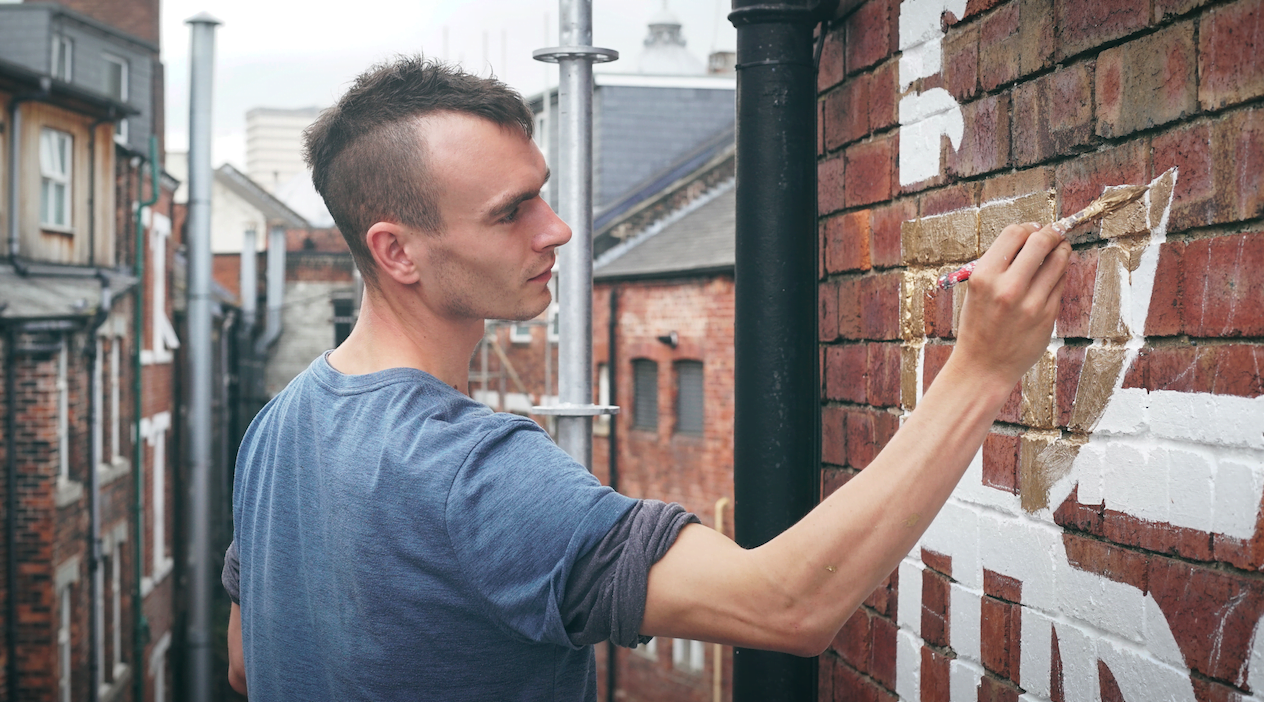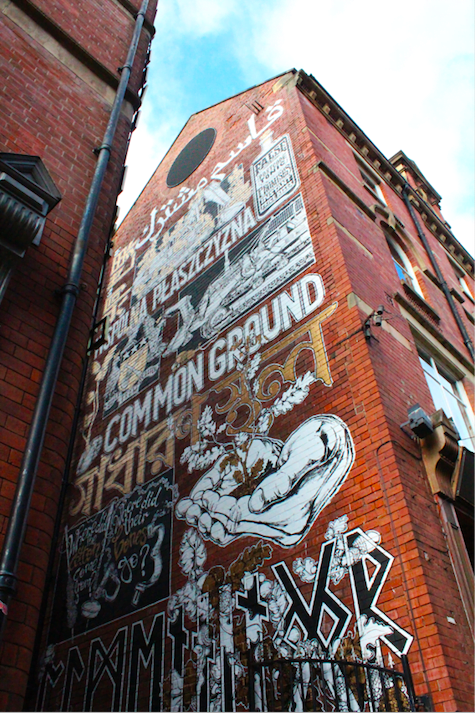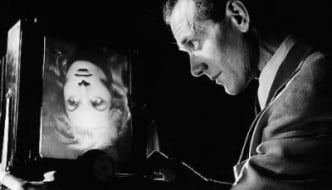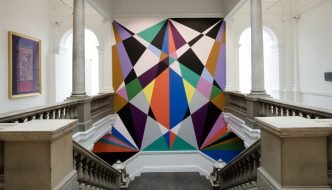Street artist Mike Winnard on mining Leeds’ history for new mural ‘Common Ground’
December 2, 2018

You may have noticed some of the vibrant street art livening up the walls around the city centre of Leeds. A City Less Grey is the project led by East Street Arts and LeedsBID behind these shiny new celebrations of the city and its communities. Leeds based artist and co-director of Assembly House Artist Studios, Mike Winnard, was one of a handful of artists chosen to create a unique public art piece to represent the history and spirit of Leeds. I speak to Mike to discuss the inspiration, development and significance of his piece, entitled Common Ground.
It is fitting that Mike’s mural takes pride of place in the city’s oldest area, Kirkgate. Mike muses that “there’s so much to mine historically for the piece so it was really lucky that it ended up there”. Taking three weeks to paint, a lot of which was spent on scaffolding looking down at passers-by, the mural takes over fifteen metres of wall on the side of New York House on Harper Street. Prior to this, Mike undertook detailed research in and around Leeds to inform his work. I ask about the development of the project pre- and post- all of Mike’s research after he reveals that the piece changed quite a lot: “The original conception was a lot more vague in the terms of imagery that was in it; it was mostly pictures of hands and pigeons and doves. The final mural that I arrived at has a lot more coded references in it to different things which weren’t in the original design.”
Much of our conversation revolves around Leeds’ endlessly rich history. Mike is full of stories from the city’s past dating back to the Norse period, and it seems that Common Ground is as much a creative excavation of the city’s identity over time as an artistic endeavour. An expansive and bold task, I ask Mike how he went about researching such a project. He mentions his first port of call as the local historical societies, the Leeds Civic Trust down the road from the mural, and a particularly helpful pair of local historians, Steve Burt and Kevin Grady, authors of A History of Kirkgate from Earliest Times to 1800, who were able to point Mike in the right direction. In particular Mike praises the “super helpful” staff at the top floor of the City Library alongside some worthwhile hours spent pouring over books at the lesser known Leeds Library at which Mike happened to have a membership for the year. However, Mike is keen to point out that his approach to research steered away from being too academic: “I was just trying to sample lots of different stuff in a slightly more inquisitive way without having a fixed research topic in mind just to see what sprang out which is really great because it means that certain unexpected kind of links pop out.”
As Mike reveals, one extraordinary connection to Kirkgate is its history of “potion sellers and fake wizards which used to operate in the area around the markets, creating a real epidemic”. Mike mentions a particularly notorious character by the name of Henry Harrison – “You’d probably find a quick summary of his story with a quick Google search. There were loads of colourful characters!”
Aside from Kirkgate’s magical roots, Mike explains his exploration into its importance as the birthplace of one of the earliest friendly societies in England where its members, called Foresters, met at the Old Crown Inn back in the late eighteenth century. “The Foresters were originally a kind of pre-police which would look after land rights and poaching in communal forests. They were basically almost insurance societies and a kind of mutual aid which was set up in response to the land enclosures, and the Ancient Order of the Foresters was basically set up to look out for its members in response to common land being taken away from the people who would historically benefit from it. That started in Kirkgate so that seemed like a nice link to public land and mutual support in the area.”
Moving onto the community as it stands today, we both agree that the mural’s location is perfect for its surrounding creative hubs with the Art Hostel, Wapentake, Fred Aldous and Tribe Records all within a few minutes’ walk. Mike muses on the changes within the area: “Obviously Crowd of Favours has been in that area for a couple of years and so there’s the tension between the development which really is bringing life back into the area and the development which actually threatens the people who planted the flags in the first place.”

With so much history and a flourishing art scene, I inquire into how Mike made sure to incorporate this into the piece and give Common Ground its own Leeds identity. One of the key ways Mike has weaved the cultural fabric of Leeds into the piece is through different languages. Mike explains that he wanted to include words from the most commonly spoken languages in Leeds and adds that “the translations as far as possible were all done by local people. I went to poets and academics and historians because I was keen for the translations to retain the double meaning of common ground as both shared physical space – which is what public space is – and as a meeting point between different viewpoints. So some of the translations weren’t literal translations of the phrase. Otherwise, they would have lost that double meaning.”
As a public art piece, it seems apt to also ask about any notable interactions Mike encountered with the general public while painting. Mike chuckles and alludes to the pubs nearby the mural. “Late at night you’d get a few people shouting out words of encouragement or feedback which is great fun. There’s a top floor apartment parallel to the alleyway in which I was working and every so often the guy who lived there would poke his head out and shout out, ‘how’s it going?’ and ‘what’s up with this bit?’ or ‘what does that bit mean?’ over the course of the month.”
The reception to Mike’s piece has been overwhelmingly positive, and although the piece provokes a lot of questions about the stories behind each image, Mike is keen for the mural to remain open to interpretation. “I wanted it to all be stuff where the meaning doesn’t necessarily have to be apparent to someone looking at it. In fact, it’s probably better that it isn’t, otherwise it has just a very singular meaning and it’s kind of face value. But if the stuff’s slightly cryptic then you have to look at it and try and work out what it means for yourself.”
Filed under: Art & Photography
Tagged with: Art Exhibition, artist, Assembly House, East Street Arts, local artists, painting, public art



Comments